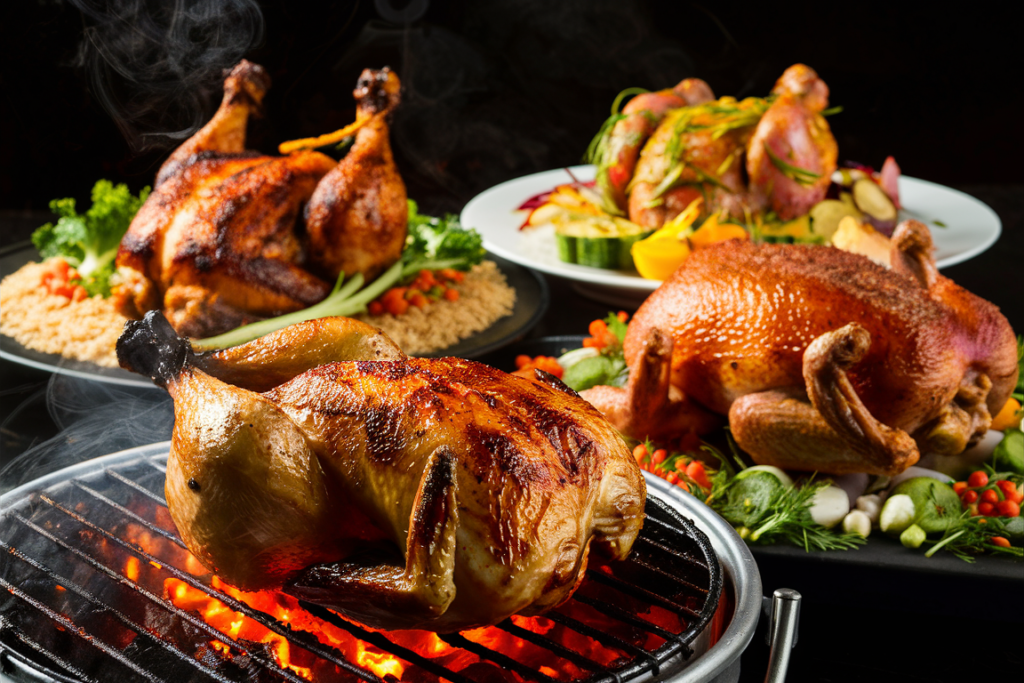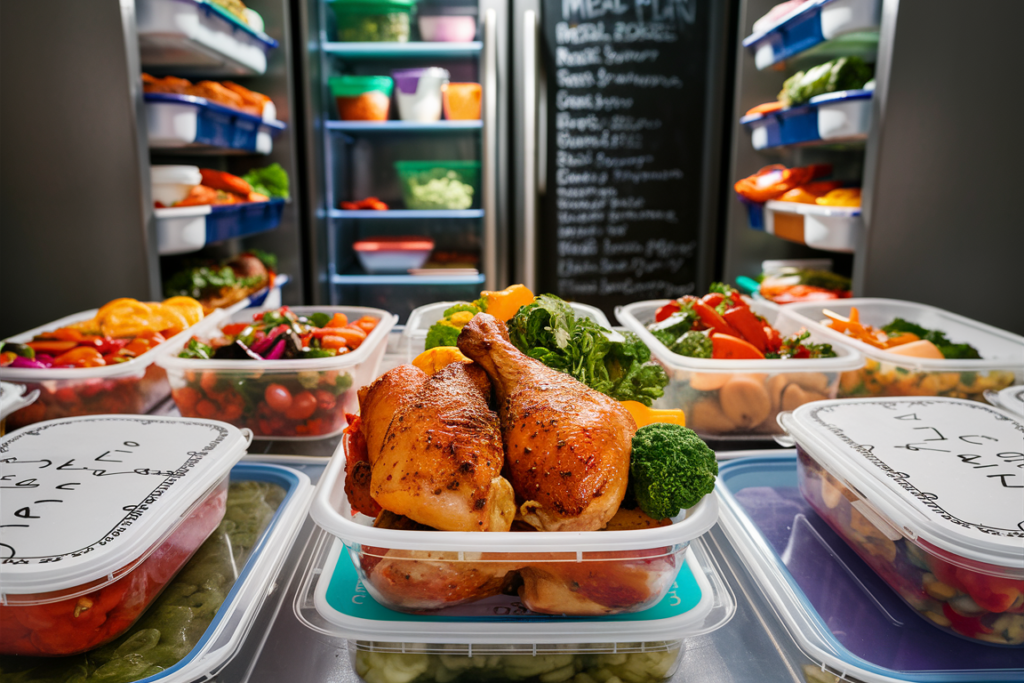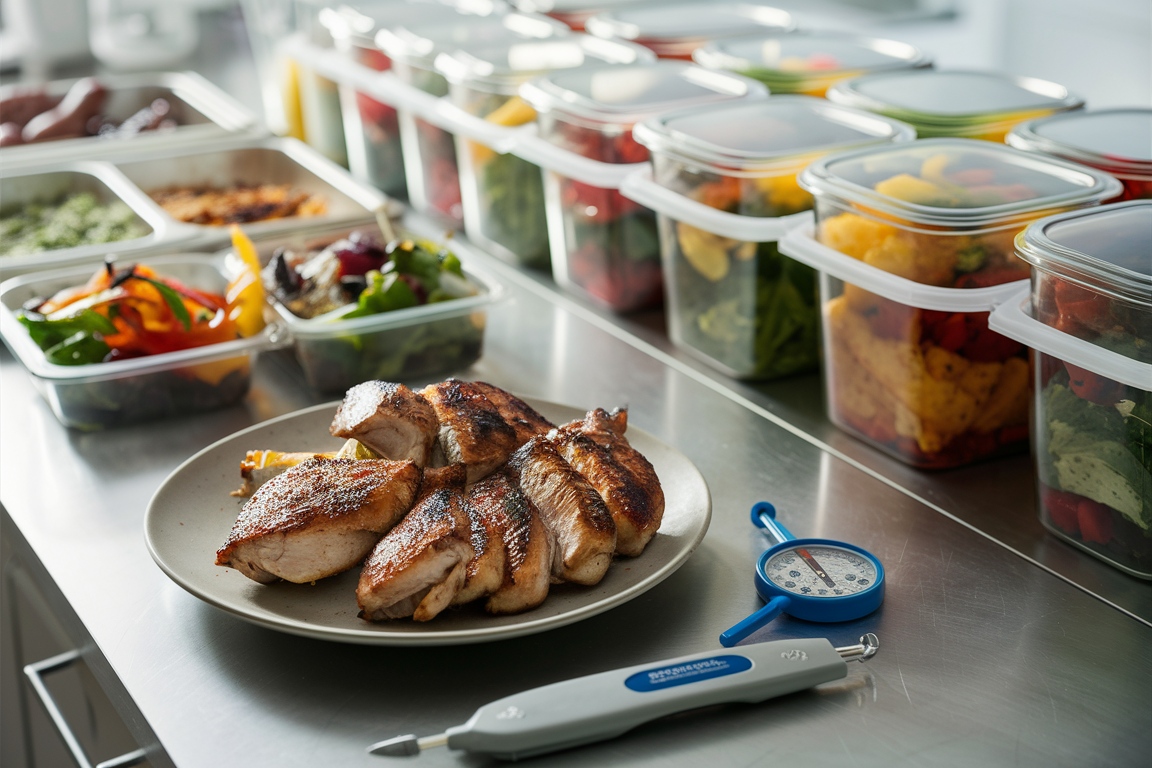Meal Prepping Chicken for a Week – Is It Safe?
Meal prepping has become a go-to strategy for many busy individuals seeking to save time, reduce stress, and maintain a healthy lifestyle. But when it comes to meal prepping chicken, safety concerns are a hot topic. Let’s dive deep into the essentials of prepping chicken for a week, exploring how to keep it both safe and delicious.
Part 1: Understanding Meal Prep Basics
What is Meal Prepping?
Meal prepping is the process of planning, preparing, and portioning meals in advance, typically for a week. The goal is to minimize daily cooking, reduce food waste, and ensure healthier eating habits. Prepping chicken for the week can include cooking and storing it in portions that make reheating quick and easy.
Why is meal prepping so popular? It’s all about convenience. Whether you’re a busy professional, a fitness enthusiast, or a parent managing household meals, meal prepping offers structure and simplicity to your weekly routine.
Benefits of Meal Prepping Chicken
Chicken is a standout choice for meal prep due to its versatility and nutritional value. Here’s why:
- Time-saving: Cooking in bulk reduces the time spent in the kitchen during the week.
- Cost-efficiency: Buying chicken in bulk is often more economical.
- Nutritional advantages: Chicken is a lean protein source, making it ideal for muscle repair and weight management.
Did you know? Preparing meals ahead can also help control portion sizes, reducing overeating and supporting weight loss goals. Learn more about how meal prep saves money and calories.
General Safety Guidelines for Meal Prep
To keep your meal prep safe, follow these essential tips:
- Always wash your hands before handling food.
- Use separate cutting boards for raw chicken and other ingredients.
- Store cooked chicken in airtight containers to avoid contamination.
- Cool and refrigerate cooked chicken within two hours to prevent bacterial growth.
These foundational hygiene practices are critical to maintaining food safety.
Why Chicken is Popular for Meal Prep
Chicken is a staple in meal prep due to its adaptability in recipes and affordability. A single batch of chicken can be flavored in various ways, from spicy marinades to sweet glazes, offering diverse meal options throughout the week. It also pairs seamlessly with sides like rice, quinoa, or roasted vegetables.
Pro tip: Choose boneless, skinless chicken breasts for the easiest meal prep or chicken thighs for extra flavor.
Shelf Life of Cooked Chicken
How long can you store cooked chicken safely? According to USDA guidelines, cooked chicken can be stored in the refrigerator for up to 3-4 days and in the freezer for up to 4 months. Beyond these timeframes, the quality deteriorates, and the risk of foodborne illness increases.
- Fridge: Store at 40°F or below in airtight containers.
- Freezer: Ensure proper wrapping to prevent freezer burn.
Understanding these timelines is essential to avoid waste and ensure safety.
How Meal Prep Impacts Food Quality
Meal prepping can slightly affect the texture and taste of chicken over time. Reheating chicken can lead to dryness if it’s not stored or reheated correctly. To maintain moisture:
- Use airtight containers to lock in freshness.
- Add sauces or broths when reheating.
Common Misconceptions About Meal Prepping Chicken
There are several myths about meal prepping chicken:
- “Chicken goes bad in two days.” – Not true if properly stored.
- “Reheating chicken makes it unsafe.” – Safe reheating methods kill bacteria.
- “Freezing chicken ruins its quality.” – Proper freezing preserves both taste and texture.
By understanding the facts, you can confidently prep chicken for the week.
Importance of Portion Control in Meal Prepping
Portioning your chicken meals ensures:
- Optimal freshness: Smaller portions reheat more evenly and quickly.
- Safety: Only reheat what you’ll consume to avoid repeated reheating, which can compromise safety.
- Balanced nutrition: Pair chicken with appropriate servings of grains, veggies, and fats.
Kitchen Equipment for Meal Prep
The right tools can streamline your meal prep process:
- Sharp knives: For precise cutting and portioning.
- Cutting boards: Designate separate ones for raw meat.
- Airtight containers: Ideal for storage and reheating.
- Food thermometer: Ensures chicken is cooked to 165°F.
Investing in quality equipment not only saves time but also boosts food safety.
Planning Your Weekly Chicken Meal Prep
Here’s how to create an effective meal prep plan:
- Decide your recipes: Choose a mix of flavors to avoid monotony.
- Buy in bulk: Look for deals on high-quality chicken.
- Prep on one day: Set aside a few hours to cook and portion meals.
- Label your containers: Include dates to keep track of freshness.
Bonus tip: Incorporate variety with marinades and spices to keep meals exciting.
Sure thing! Let’s continue with Part 2, focusing on safe practices for chicken meal prep to ensure your weekly meals are both delicious and risk-free. Here we dive into everything from buying the best chicken to safely cooking, storing, and reheating it.
Part 2: Safe Practices for Chicken Meal Prep
Choosing the Right Chicken for Meal Prep
When meal prepping, starting with the right ingredients is critical for success.
- Fresh Chicken: Look for pinkish-colored meat with no strong odor. Check the packaging date to ensure freshness.
- Frozen Chicken: Buying frozen is a good option for longer-term meal prep. Look for chicken with minimal added water or salt, as these can affect both quality and nutrition.
The choice between fresh and frozen really depends on your preferences and how far in advance you’re prepping. Both can be safe and healthy options as long as you handle them properly.
Proper Chicken Handling Techniques
Cross-contamination is a major risk when preparing chicken. Follow these techniques to minimize risks:
- Separate Cutting Boards: Use one cutting board for raw chicken and a different one for vegetables and cooked food.
- Hand Washing: Wash your hands with soap and warm water for at least 20 seconds after handling raw chicken.
- No Rinse Needed: Contrary to popular belief, you should not rinse raw chicken—doing so can spread bacteria around your kitchen surfaces.
Pro Tip: Clean countertops and any surfaces raw chicken touched with a disinfectant to prevent cross-contamination.
Cooking Chicken to Safe Temperatures
Chicken needs to be cooked thoroughly to kill harmful bacteria, such as salmonella and campylobacter.
- Use a Meat Thermometer: Always cook chicken until the internal temperature reaches 165°F (74°C). Insert the thermometer into the thickest part of the meat without touching bone for an accurate reading.
- Avoid Guessing: Visual clues like clear juices or white meat aren’t always accurate indicators of doneness—always rely on temperature.
Bonus Tip: Cooking chicken in bulk in a slow cooker can make reaching a safe temperature easier while retaining moisture.
Immediate Cooling and Storing After Cooking
After cooking, the way you cool and store your chicken makes all the difference for food safety.
- Cooling Quickly: Once cooked, let the chicken cool for no more than 30 minutes. Dividing it into smaller portions speeds up the cooling process.
- Store in Airtight Containers: Airtight containers prevent bacterial growth by keeping air out. Glass containers can be a good choice because they’re durable and microwave-safe.
Avoid leaving cooked chicken out for more than 2 hours—this is crucial to prevent harmful bacteria from developing.
Packaging Tips for Freshness
Proper packaging not only keeps your chicken safe but also helps maintain its quality throughout the week.
- Airtight Containers or Vacuum Sealers: The less air present, the fresher your chicken will stay. Vacuum sealers are particularly effective for longer storage.
- Labeling: Clearly label each container with the cooking date. This helps track how long each portion has been stored and ensures nothing stays past its safe period.
Pro Tip: You can also marinate your chicken before storage to infuse flavors and maintain moisture during reheating.
Refrigerator vs. Freezer Storage
Knowing when to refrigerate and when to freeze your chicken is key to maintaining safety and quality.
- Refrigerate for Up to 4 Days: If you plan to eat your meal-prepped chicken within a few days, refrigerating is perfectly fine. Just be sure to store it in airtight containers.
- Freeze for Longer Storage: If you plan to eat chicken beyond four days, freeze it. Make sure it’s tightly wrapped to prevent freezer burn, which impacts taste and texture.
Reheat directly from frozen or thaw in the fridge overnight. Avoid thawing on the counter, as it can lead to bacterial growth.
Reheating Chicken Safely
Reheating can be tricky if you want to preserve both safety and taste.
- Heat to 165°F Again: Reheat chicken until it reaches an internal temperature of 165°F to ensure it’s safe.
- Avoid Overheating: Overheating chicken can cause it to become dry and tough. Add a splash of water or broth when reheating in the microwave to maintain moisture.
- Microwave Tip: Stir or flip the chicken midway through microwaving to ensure even heating, especially when reheating pieces of different sizes.
Check out these step-by-step tips for keeping reheated chicken moist and delicious.
Avoiding Common Mistakes in Meal Prep
When it comes to meal prepping chicken, these common mistakes can put food safety at risk:
- Improper Storage Containers: Always use airtight, food-safe containers.
- Leaving Cooked Chicken at Room Temperature: Never leave chicken out for extended periods after cooking.
- Reheating Multiple Times: Avoid reheating more than once—only heat what you plan to eat to minimize risks.
Proper planning can help you avoid these common errors and enjoy your meal prep safely.
Understanding Foodborne Illness Risks
Chicken is a high-risk food for bacteria like salmonella and campylobacter. Symptoms of foodborne illness include nausea, vomiting, stomach cramps, and diarrhea. Following food safety best practices is crucial to avoid these risks.
- Preventing Cross-Contamination: Always sanitize surfaces and wash hands thoroughly.
- Safe Cooking and Storing Temperatures: Keeping chicken at the right temperatures, whether cooking, cooling, or reheating, is key to preventing bacterial growth.
Fun Fact: A food thermometer isn’t just for cooking—use it to check refrigerator temperatures too (it should be below 40°F).
Signs of Spoiled Chicken
Spotting spoiled chicken early prevents the risk of foodborne illnesses.
- Odor: Spoiled chicken has a sour, off-putting smell.
- Texture: If it feels slimy or sticky, it’s past its prime.
- Appearance: Chicken that turns a gray or greenish color should be discarded immediately.
If you notice any of these signs, do not take any chances—throw the chicken out. Your health is far more valuable than a meal.
Great! Let’s proceed to Part 3, where we’ll explore ways to enhance your chicken meal prep experience. This section will focus on making your meal prep flavorful, diverse, and nutritious while keeping it sustainable and budget-friendly.
Part 3: Enhancing Your Chicken Meal Prep Experience
Flavoring Chicken for Meal Prep
Prepping chicken in bulk doesn’t mean compromising on flavor. There are plenty of ways to keep your chicken exciting throughout the week.
- Marinades: Marinating your chicken before cooking is a great way to infuse flavors. Some popular options include lemon herb, honey garlic, and teriyaki. Aim to marinate for at least 30 minutes, or overnight for deeper flavor.
- Dry Rubs: If marinating isn’t an option, try dry rubs. Seasonings like paprika, cumin, garlic powder, and Italian herbs can transform your meal.
- Cooking Styles: Roasting, grilling, and slow-cooking each bring different tastes and textures. Grilled chicken has that smoky flavor, while slow-cooked chicken is juicy and tender.
Pro Tip: Prepare multiple marinades or rubs, divide your chicken portions, and apply a different flavor to each. This way, you’ll have a different taste every day!
Best Chicken Meal Prep Recipes
To help make your meal prep more enjoyable, here are a few go-to chicken meal prep recipes:
- Honey Garlic Chicken Thighs with Roasted Veggies
- Sweet and savory chicken thighs paired with a mix of roasted veggies like broccoli, carrots, and sweet potatoes.
- Chicken Burrito Bowls
- Brown rice, black beans, corn, and bell peppers combined with seasoned shredded chicken for a nutritious and filling meal.
- Lemon Herb Grilled Chicken with Quinoa Salad
- Fresh and zesty grilled chicken served over quinoa, cherry tomatoes, cucumbers, and a dash of feta cheese.
- Buffalo Chicken Wraps
- Shredded buffalo-flavored chicken wrapped in whole wheat tortillas with lettuce, cheese, and ranch or blue cheese dressing.
- Asian-Inspired Chicken Stir-Fry
- Stir-fried chicken with broccoli, bell peppers, onions, and a soy-based sauce, served over brown rice or noodles.

Mixing up recipes like these each week keeps your meal prep interesting and ensures you look forward to each meal.
Incorporating Variety in Meal Prep
Variety is the spice of life, and it’s easy to bring it into your meal prep plan. Pairing your chicken with different sides and ingredients can make a huge difference:
- Grains: Rotate between brown rice, quinoa, couscous, or wild rice.
- Vegetables: Opt for steamed broccoli, roasted Brussels sprouts, sautéed spinach, or carrots.
- Sauces and Dressings: Keep a few sauces on hand to switch things up—sriracha mayo, tzatziki, peanut sauce, or pesto can take a simple chicken dish to the next level.
Switching sides and using different flavor profiles each day helps break the monotony of eating chicken all week long.
Nutrition Considerations for Chicken Meal Prep
When meal prepping chicken, consider its nutritional value and how to balance your plate.
- Protein: Chicken is high in protein, which is essential for muscle repair and growth. Aim for about 4-6 ounces of cooked chicken per serving, depending on your dietary needs.
- Balanced Macros: To create balanced meals, pair chicken with complex carbs (like quinoa or sweet potatoes) and healthy fats (like avocado or olive oil).
- Portion Control: Pre-portioning your meals helps control calorie intake and ensures you’re getting enough nutrients each day.
By considering the right balance of macros, you can tailor your meal prep to fit any diet or fitness goal.
Storage-Friendly Side Dishes with Chicken

Not all sides are created equal when it comes to meal prep. Choose sides that can maintain freshness throughout the week:
- Roasted Vegetables: Broccoli, cauliflower, sweet potatoes, and bell peppers retain their texture and flavor well.
- Grains: Quinoa and rice hold up well in the fridge, making them excellent choices for meal prep.
- Legumes: Lentils and chickpeas can be paired with chicken for added protein and fiber.
Pro Tip: Avoid sides like leafy greens that wilt quickly—if you want a salad, add the greens fresh right before eating.
Using Technology in Meal Prep
Technology can make meal prepping more efficient and fun.
- Apps: Apps like Mealime, Paprika, or Yummly help plan meals, create shopping lists, and provide recipe ideas.
- Gadgets: A slow cooker or instant pot is perfect for cooking large batches of chicken with minimal effort. A food scale helps you portion meals precisely, and a vacuum sealer keeps prepped meals fresh for longer.
Using tech tools simplifies meal prep and makes it a lot more manageable.
Sustainability and Meal Prep
Meal prepping can be an eco-friendly practice if you plan carefully.
- Reduce Food Waste: Only buy what you need for the week to minimize waste. Meal planning helps you use ingredients fully, avoiding spoilage.
- Reusable Containers: Use glass containers or BPA-free plastic for storage. Reusable containers not only reduce waste but also ensure your meals are stored safely.
- Recycle Packaging: Many bulk chicken packs come in recyclable packaging—make it a habit to recycle whenever possible.
Sustainable practices in meal prep help reduce your carbon footprint while keeping your meals delicious.
How to Meal Prep on a Budget
Meal prepping can also help you save money:
- Buy in Bulk: Purchase family-sized packs of chicken, especially during sales, and freeze what you won’t use immediately.
- Choose Affordable Ingredients: Brown rice, beans, and seasonal vegetables are nutritious but inexpensive. Incorporate them often to stretch your budget.
- Plan Around Sales: Plan meals based on weekly grocery sales or discounts. Cooking around deals is a great way to save money without sacrificing variety.
Budgeting and meal prep can work together seamlessly to save you both time and cash.
Adapting Chicken Meal Prep for Special Diets
Chicken meal prep is easily adaptable for various dietary needs:
- Keto-Friendly: Use chicken thighs with a high-fat marinade, like garlic butter, and pair with non-starchy veggies like broccoli or cauliflower rice.
- Gluten-Free: Pair chicken with quinoa, sweet potatoes, or zoodles (zucchini noodles) for a gluten-free, nutritious meal.
- Low-Calorie: Opt for grilled chicken breast with a side of roasted veggies. Avoid adding heavy sauces and opt for fresh herbs instead.
By adapting meal prep to suit dietary restrictions, you can stay on track with your health goals.
Long-Term Benefits of Meal Prepping Chicken
Meal prepping chicken not only saves time and money, but it also offers long-term lifestyle benefits:
- Reduced Stress: Knowing that your meals are already prepared helps you focus on other aspects of life without worrying about dinner.
- Healthy Eating Habits: Pre-portioned, nutritious meals reduce the temptation to reach for unhealthy fast food options.
- Time Management: Prepping meals once a week opens up more time for hobbies, family, or relaxation on busy weekdays.
Long-term meal prepping helps build sustainable habits that positively affect both your mental and physical well-being.
This concludes Part 3 of our guide on meal prepping chicken for a week. We’ve explored how to make meal prepping more enjoyable, nutritious, and budget-friendly, as well as sustainable.

